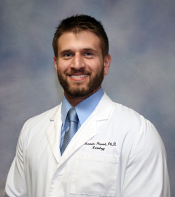Program Information
Y90 PET/CT for the Instantaneous Determination of Both Target and Non-Target Absorbed Doses Following Hepatic Radioembolization
A Pasciak1*, J Kao2 , (1) University of Tennessee Medical Center, Knoxville, TN, (2) University of Tennessee Medical Center, Knoxville, TN
Presentations
SU-E-CAMPUS-I-6 Sunday 3:00PM - 6:00PM Room: Exhibit HallPurpose
The process of converting Yttrium-90 (Y90) PET/CT images into 3D absorbed dose maps will be explained. The simple methods presented will allow the medical physicst to analyze Y90 PET images following radioembolization and determine the absorbed dose to tumor, normal liver parenchyma and other areas of interest, without application of Monte-Carlo radiation transport or dose-point-kernel (DPK) convolution.
Methods
Absorbed dose can be computed from Y90 PET/CT images based on the premise that radioembolization is a permanent implant with a constant relative activity distribution after infusion. Many Y90 PET/CT publications have used DPK convolution to obtain 3D absorbed dose maps. However, this method requires specialized software limiting clinical utility. The Local Deposition method, an alternative to DPK convolution, can be used to obtain absorbed dose and requires no additional computer processing. Pixel values from regions of interest drawn on Y90 PET/CT images can be converted to absorbed dose (Gy) by multiplication with a scalar constant.
Results
There is evidence that suggests the Local Deposition method may actually be more accurate than DPK convolution and it has been successfully used in a recent Y90 PET/CT publication. We have analytically compared dose-volume-histograms (DVH) for phantom hot-spheres to determine the difference between the DPK and Local Deposition methods, as a function of PET scanner point-spread-function for Y90. We have found that for PET/CT systems with a FWHM greater than 3.0 mm when imaging Y90, the Local Deposition Method provides a more accurate representation of DVH, regardless of target size than DPK convolution.
Conclusion
Using the Local Deposition Method, post-radioembolization Y90 PET/CT images can be transformed into 3D absorbed dose maps of the liver. An interventional radiologist or a Medical Physicist can perform this transformation in a clinical setting, allowing for rapid prediction of treatment efficacy by comparison to published tumoricidal thresholds.
Contact Email:


